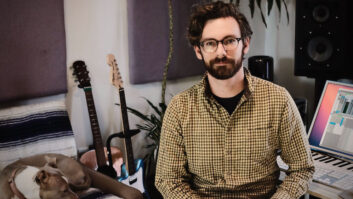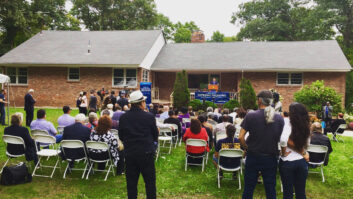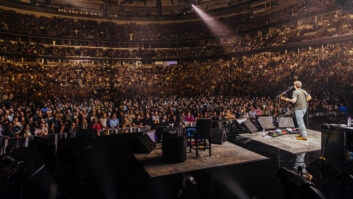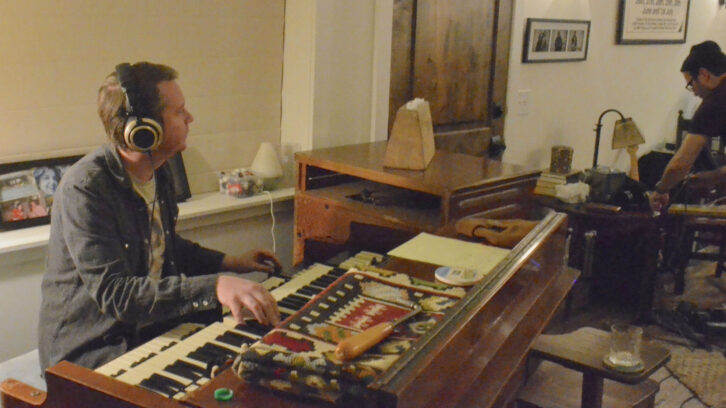
Since releasing his Grammy-nominated album Songs in 2014, singer/songwriter John Fullbright has been spreading himself thinner: playing keys on other artists’ records and jamming with other local musicians. Fullbright’s first album in eight years, The Liar (September 2022, Thirty Tigers), is a testament to his close-knit community of talented Oklahoma musicians, whom engineer/producer/musician Jason Weinheimer calls the “Tulsa Usual Suspects.”
“For example, the drummer on The Liar is Paddy Ryan,” Weinheimer says. “I’ve made 20 records with Paddy.” The other players on Fullbright’s album include guitarists Jesse Aycock and Stephen Lee, upright bassist Paul Wilkes, and electric bassist Aaron Boehler.
“They’re my first call when I bring session musicians in, even though they’re four hours up the road,” says Weinheimer, who is based in Little Rock, Ark., but started his career in Tulsa. “They’re the group of musicians that John fell in with when he moved to Tulsa, and he became one of them. He’s been immersing himself in this community, and that’s part of what he wanted to capture on this record: that dynamic, collaborative aspect of playing together.”
The latest crop of John Fullbright tracks ranges from the charming Jonathan Richman-ish “Social Skills,” to the Copperphone-distorted screamer “Poster Child,” to the deeply moving ballad “Stars.”
“That song, ‘Stars,’ is one that he’s been playing for a couple of years,” Weinheimer says. “John sent me a Dropbox full of demos before we started tracking, just voice memos with him playing acoustic guitar or piano. I put them on during dinner one night, and when his demo for ‘Stars’ popped up, I realized, ‘Oh I get to record that song!’ I felt this weight and responsibility—I didn’t want to mess it up! But I couldn’t have messed it up. It’s that good of a song, and he performs it so beautifully.”
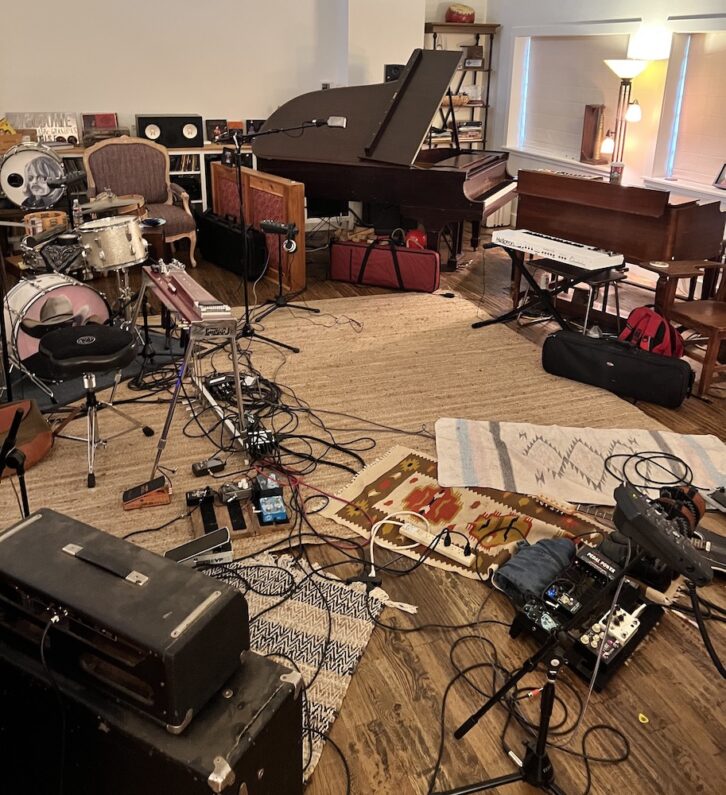
Weinheimer and the musicians tracked in a studio that’s commonly referred to as the “Ripley Farm,” or the “Farmhouse Studio.” It was originally built and operated by the late Steve Ripley, the Tractors’ frontman/guitarist, who also amassed credits as a producer, engineer and songwriter before his death in 2019.
“Steve worked with Leon Russell, Dylan, JJ Cale—so many people—and operated his other studio, The Church, for almost 20 years,” Weinheimer says, “but around 2006, he left Tulsa and moved back to his family farm across the state, and he built his dream residential studio compound. He converted a cow-milking barn into a control room and then purpose-built a brand-new building on the land. It’s a beautiful, large-family farmhouse, but the living room has 15-foot ceilings and was built according to the Golden Ratio. His idea was he would have bands stay in the bedrooms, wake up and have coffee, and then push the furniture to the side and just play.
“Unfortunately, he died before he ever got to make a record that way. This record that we made with John was actually the first record where the studio was used the way Steve had envisioned it. We set everybody up in a circle in the living room and isolated the guitar amps down the hall in bedrooms.”
The guitar amps were mainly Fender Deluxes, which Weinheimer miked using a couple of his vintage beyerdynamic M81s. “Stephen [Lee] also has a Supro that he would switch out when he wanted something a little nastier than a Fender. Both guitarists are Telecaster guys, but Jesse also uses a Strat sometimes.
“There’s another interesting guitar on the song ‘Gasoline,’” Weinheimer continues. “Steve [Ripley] was a guitar builder and tinkerer, and in one of the back bedrooms the first night, I found this guitar hanging on the wall that I was immediately drawn to; it was a Danny Ferrington prototype. Danny is another guitar mad-scientist guy. It’s an acoustic that Ripley modified by bolting a Tele bridge to the top and putting a Tele pickup in the sound hole. Charlene, Steve’s wife, told me that’s the guitar that Steve played on ‘Baby Likes to Rock It,’ which was The Tractors’ huge hit that established Steve and allowed him to build the studio that we were out there enjoying. So Jesse played that guitar on ‘Gasoline’; it’s really unique-sounding.”
Proceeds from the Tractors’ biggest song also fueled the Ripleys’ search for the piano that Fullbright plays on this album. “Steve bought an 800 number when that was a thing,” Weinheimer says. “It was something like 1-800-IBUYSTEINWAYS. They would get calls, and Charlene says that at one point, they had eight Steinways at the same time! Eventually, they decided this one is the keeper. When the piano turned 100 years old, they had a party for it, and they had John come and play piano for the birthday party.”
Inside the ‘Billy Joel: Live at Yankee Stadium’ Atmos Mix
For The Liar, Weinheimer built his recording setup around that 7-foot Steinway B and captured it via two of the studio’s Neumann KM84s. The sessions began with the intention that Fullbright would sing scratch vocals live with the band and recut vocals to the studio’s Neumann U48 mic later, but the vibe off the floor was so good that the artist suggested they go for keeper vocals live with the band.
“I did have a hunch he’d do some live vocals, so I brought a Lauten LS-208, a condenser mic that’s designed to be used like a [Shure] SM7,” Weinheimer says. “People who gig a lot like it because they can eat the mic, but it has beautiful high-end detail and condenser qualities, yet it has great rejection. I had that on a boom, in front of him at the piano, or I would move it over to his acoustic guitar station when he played guitar.
“One of the things that John said from the very beginning was, ‘This room sounds beautiful—so musical. I want to capture the room,’” Weinheimer continues. “I actually dedicated my best and favorite mic to the room: my AEA R88 stereo ribbon mic. Normally that’s my drum overhead, but it was in the middle of the room the entire time, capturing everything.”
That, of course, meant Weinheimer had to rethink his usual drum-miking scheme. “Before the session, I bought a Stager stereo ribbon mic, the SR-2N; there’s a guy in Nashville who makes them,” he says. “I was really happy with how it performed. I had a Sennheiser e-602 on kick, a Beyer M-201 on snare top and a vintage Sennheiser MD403 on snare bottom, but I don’t usually mic toms or hi-hats. I’ll take the overhead and blend in some kick or snare, and that’s my drum sound.”
Most of the tracking happened in just a couple of days, with day one devoted to tracks with the upright bass—captured via DI plus a FET 47—and day two to songs featuring electric bass, which was taken direct. The few overdubs they did later included the odd guitar addition or fix, a few vocals, Fullbright’s luminous piano- and-voice performance of “Stars,” and his B3 or Wurlitzer parts. However, Weinheimer points out that on one song, the Wurly was tracked live.
“The song ‘Safe to Say,’ the next to last song on the record, was the last song we cut,” he explains. “We thought we were done tracking, but we had some time at the end of the second day, and John said, ‘I’ve got this other song, so maybe before the bass player leaves…’ He started on the piano, but then Jesse suggested it might be cool on the Wurlitzer.
“The Wurlitzer was set up so close to the drums, the drummer could have just reached over and played it, but because that last song was just sort of an afterthought, I didn’t think about moving it. I just moved the vocal mic over there, and I robbed a mic from the bottom of the snare and put it on the Wurly, and they did it live in one take. It’s one of the most incredible vocals toward the end when John starts giving it hell; I get goosebumps every time I hear it.”



